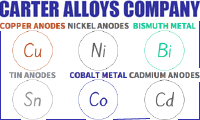
Curated with aloha by
Ted Mooney, P.E. RET

The authoritative public forum
for Metal Finishing 1989-2025

-----
How to remove small traces of Pb on a Lead-free plating solution?
Hi to all. We have a slightly disturbing problem with our plating process. We found small traces of Lead (Pb) on our Lead-free plated devices. It's not that much, just a little (34 ppm) over the RoHS limit of 1000 ppm. We have plans to clean the bath, and to replace the entire plating solution but that would be costly. Is there any other way we can remove the Lead content from our solution? Thank you.
Manuel DariaEngineer - Rosario, Cavite, Philippines
July 21, 2008
First of two simultaneous responses --
What type of plating baths are these?
You need to determine where the lead is getting into the baths and stop the source.
process supplier - Great Neck, New York
July 22, 2008
Second of two simultaneous responses -- July 23, 2008
Manuel,
Before considering how to remove the lead, you had better find the source of the contamination. if you don't your bath will get recontaminated and you'll be back to square one.
Once you have established the source of contamination and removed it I would personally just discard the solution and start again. you could play with the addition of possible precipitating agents such as barium carbonate but this may well upset the chemistry of the bath and should only be done on a laboratory size sample first. You may also consider dummying out the bath for a while. That may help drop below the 1000ppm requirement.
Aerospace - Yeovil, Somerset, UK
Manuel,
In MSA based tin plating solution, you can precipitate the lead by adding sulfuric acid. Do the precipitation in a lab scale first to determine the quantity of sulfuric acid needed for the whole bath. Check the quality of your tin anodes. lead contamination is normally coming from the anodes.
- Laguna, Philippines
July 25, 2008
adv.: Supplier of Copper Anodes, Nickel Anodes, Bismuth Metal, & Other Metal Products for Industry & The Arts

Q, A, or Comment on THIS thread -or- Start a NEW Thread